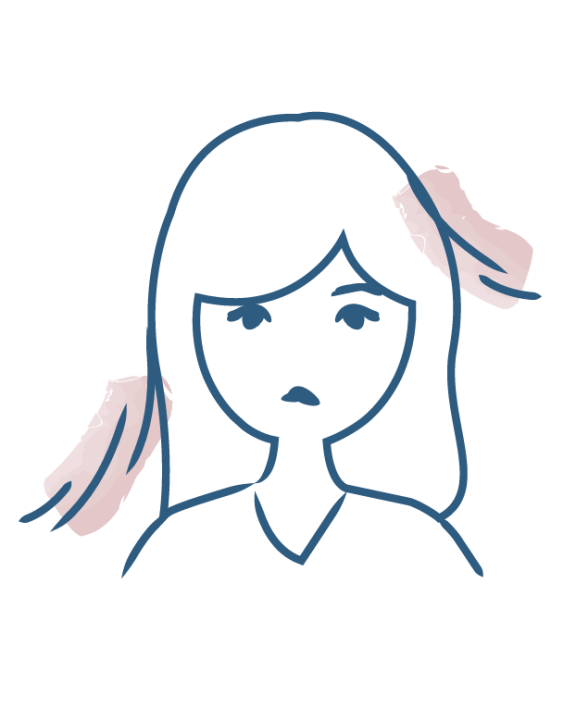What is hair loss?
The hair's life cycle
- The causes of hair loss
- Hair loss: the impact of iron, zinc, vitamin D, C and B12 deficiencies
- Hair loss and genetics
- What is traction alopecia?
- Drug-induced hair loss
- Hair loss and hormones
- Hair loss and fatigue
- Hair loss and the pill
- Secondary syphilis and hair loss
- Hair loss and menopause
- Hair loss due to ringworm of the scalp
- Spot baldness and hair loss
- Hair loss due to stress: reactional hair loss
- Scarring alopecia
- Pregnancy and hair loss: everything you need to know
- Hair loss and Covid

The hair's life cycle
New hairs appear and grow according to a very precise process known as the hair cycle. It is divided into three very distinct phases.
What does the hair cycle look like?
The hair’s growth is cyclical in nature and is characterized by phases of growth, regression and regeneration. This is referred to as the hair cycle. Each cycle is comprised of three main phases.
- The anagen phase is the hair’s growth phase and lasts two to six years. It concerns about 85% of the hair. The hair shaft is produced by the hair follicle during this phase. The characteristics of the hair follicle (size) and hair shaft (length) depend on the volume and number of cells found in the dermal papilla. During the anagen phase, fibroblasts in the dermal papilla release signals that trigger the proliferation, migration and differentiation of the matrix cells located at the base of the follicle to form the hair shaft. Over the course of this phase, hair grows approximately 1 cm per month.
- The catagen phase is the hair’s regression or degeneration phase and lasts two to three weeks. During this transitional phase, the bulb cells go into apoptosis, thus causing the regression of the lower part of the hair follicle. During this time, the bulb is inactive and the hair stops growing.
- The telogen phase is the rest phase (less than 10% of hairs are concerned), in terms of activation and proliferation. No production of the hair shaft is observed during this stage. It is during this two- to three-month hair loss phase that the dead hair falls out, having been pushed out by a new hair entering into another anagen phase.
The hair cycle: True or false
One year = one hair cycle
False- We know that, in its lifetime, the hair follicle undergoes 25 to 30 cycles on average. This is the hair’s vital cycle. Luckily, however, the number of hairs that grow is always well above the number of hairs that fall out: on a normal scalp with about 100,000 hairs, 86% of the hairs are in the anagen, or growth, phase.
The duration of the hair cycle may change
True- The hair cycle may speed up due to an excess of male hormones, androgens. This phenomenon disrupts normal hair growth. Because the hair is growing faster than usual, it becomes depleted and thinner, until it falls out permanently. This is androgenetic alopecia, a chronic hair loss (lasting more than three to six months) and is difficult to reverse. It should not be confused with seasonal hair loss, which is occasional (acute telogen effluvium) and has a more positive outcome, or with age-induced alopecia, which is caused by a reduction in the hair’s diameter associated with physiological aging of the hair.
Does the lunar cycle have an impact on hair growth?
Throughout this conventional hair cycle, the lunar calendar is thought to have an influence on hair growth. The position of the moon in the sky could promote or discourage hair follicle growth. Although this phenomenon has yet to be proven scientifically, many specialists are actively exploring the possibility.
More information
- Discover Chronic loss of hair density
What is hair loss?
Chronic loss of hair density
- Discover Androgenetic alopecia in women and men
What is hair loss?
Androgenetic alopecia in women and men
- Discover Everything you need to know about seasonal hair loss
What is hair loss?
Everything you need to know about seasonal hair loss
- Discover Localized hair loss
What is hair loss?
Localized hair loss
- Discover Hair loss in men
What is hair loss?
Hair loss in men
- Discover Diffuse hair loss
What is hair loss?
Diffuse hair loss
- Discover Hair loss in women
What is hair loss?
Hair loss in women
Our care routines
Loss of hair density, thinning hair
- Discover MY ROUTINE AGAINST CHRONIC HAIR DENSITY LOSS IN MEN (OVER 6 MONTHS)
MY ROUTINE AGAINST CHRONIC HAIR DENSITY LOSS IN MEN (OVER 6 MONTHS)
- Discover MY HAIR DENSITY LOSS ROUTINE FOR WOMEN (OVER 6 MONTHS)
MY HAIR DENSITY LOSS ROUTINE FOR WOMEN (OVER 6 MONTHS)
- Discover Anti-reactional loss of hair volume for post-pregnancy and breastfeeding women
Anti-reactional loss of hair volume for post-pregnancy and breastfeeding women
- Discover MY OCCASIONAL HAIR DENSITY LOSS ROUTINE FOR WOMEN (LESS THAN 6 MONTHS)
MY OCCASIONAL HAIR DENSITY LOSS ROUTINE FOR WOMEN (LESS THAN 6 MONTHS)
- Discover MY OCCASIONAL HAIR DENSITY LOSS ROUTINE FOR MEN (LESS THAN 6 MONTHS)
MY OCCASIONAL HAIR DENSITY LOSS ROUTINE FOR MEN (LESS THAN 6 MONTHS)
Dermatological expertise
To better understand your skin and hair, discover our exclusive content and innovative care products designed to improve your quality of life..


